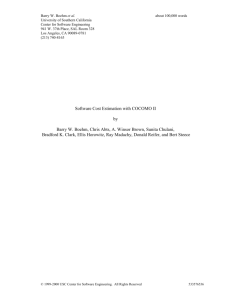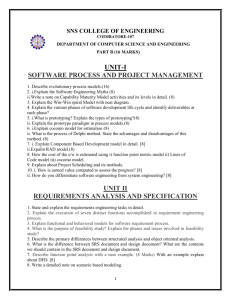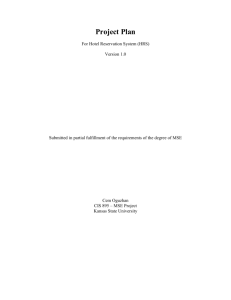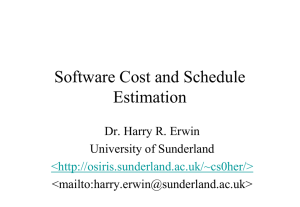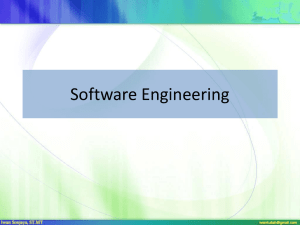COCOMO Estimating Software
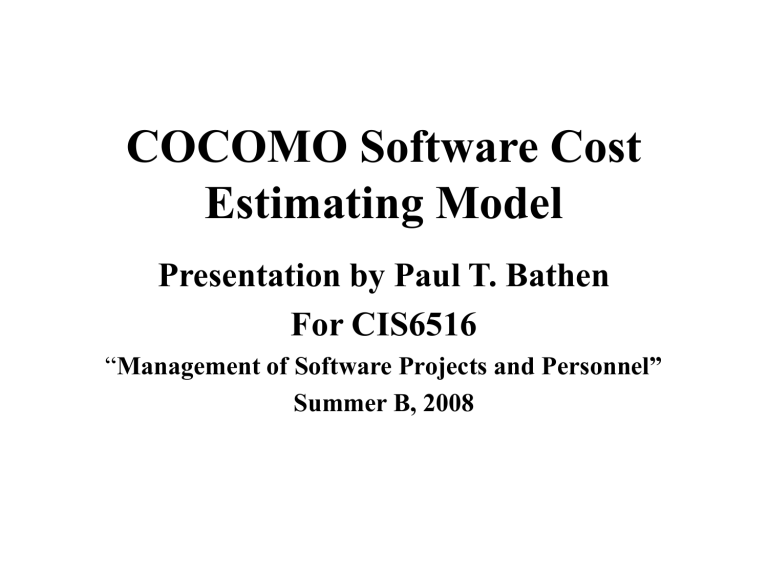
COCOMO Software Cost
Estimating Model
Presentation by Paul T. Bathen
For CIS6516
“ Management of Software Projects and Personnel”
Summer B, 2008
Outline of Presentation
• Brief overview of versions.
• Summary of email from Kurt Bittner.
• Cocomo 81; demonstration
• Cocomo II; demonstration
• CoStar by SoftStarSystems.com; demo
COCOMO Versions
• CO (Constructive) CO (Cost) MO (Model)
• First version: 1981 by Dr. Barry Boehm
– Now known now as “COCOMO 81”
• Second version: ADA Cocomo (ADA 87); parameterized exponent reflecting more modern practices and their economies of scale.
• Current Version: Cocomo II (circa 2000)
• Commercial take-offs
– Costar (Softstarsystems.com)
– Cost Xpert (CostXpert.com)
• Regression formula, with data taken from historical projects and current project characteristics.
Email from Kurt Bittner
• “Is COCOMO II best for iterative process?”
• Yes. “(the models are) public, have evolved over almost two decades, and are based on solid, proven research with solid data.”
• Caveat: COCOMO II models are “postarchitectural” (best for Construction phase).
(PTB Note: Cocomo II software allows for calculating and reporting by Early Design and Post Architecture)
Bittner email cont’d
• Inception phase: driven by business/exploratory technology issues; generally defies estimation (because so little data exists at the beginning of a project).
• Elaboration phase: driven by technical risks and exploration of technology issues.
• Transition phase: not largely governed by software economics but is affected by a large number of factors other than software development.
Cocomo 81 Accuracy
• Cocomo homepage: “Over 63 data points in the
COCOMO 81 calibration database, the
Intermediate form demonstrates an accuracy of within 20% of actuals 68% of the time for effort, and within 20% of actuals 58% of the time for a non-incremental development schedule.”
• Kemerer 1993: “(estimating in general varies) from as much as 85 - 610 % between predicated and actual values. Calibration of the model can improve these figures, However, models still produce errors of 50-100%.”
– Source: http://yunus.hacettepe.edu.tr/~sencer/cocomo.html
Cocomo 81
• Three calculation models:
– Basic: single-variable static model
• Effort in staff months = C1 b
* (KDSI) P1
• Schedule in total months= C2 * (Effort) P2
– Intermediate: Two variables.
• Effort in man months = C1 i
* EAF * (KDSI) P1
• Schedule in total months = C2 * (Effort) P2
• EAF = E1 * E2 * … E15
– Detailed: Intermediate + assessed per phase
(analysis, design, etc)
Cocomo 81
• C1
• C1 b i
* EAF * (KDSI) P1
AND
C2 * (Effort)
, C1 i
: Scaling coefficient for effort
P2
• C2: Scaling coefficient for schedule
•
EAF: Effort Adjustment Factor; 15 parameters covering Product, Personnel, Computer, and
Project familiarity.
• P1: characterization of economies of scale: ability to avoid rework, bureaucracy, communications overhead.
• P2: characterization of inherent inertia and parallelism.
• DSI: Delivered Source Instructions
Cocomo 81
• Effort =
C1* EAF * (KDSI) P1 and Sched= C2 * (Effort) P2
• * “Organic: in-house, less-complex developments with flexible processes.
Features, qualities, cost and schedule are freely changed with minimal
• overhead.
•
* Embedded: typical defense community projects. Complex, requiring high reliability, with real-time issues. Highly rigorous process. Features,
• qualities, cost and schedule are tightly controlled.
•
* Semidetached: somewhere inbetween organic and embedded.”
From the book Dr. Roggio loaned me
Cocomo 81 demo
•
See Excel demo of Cocomo 81
Cocomo 81:
Limitations as years progressed
• Software reuse
• Application generation programs
• Object oriented approaches
• Application engineering (reuse, applications translation)
• Rapid development
• Follow this link for an interesting
IBM Timeline
Cocomo 81 versus Cocomo II
Differences between Cocomo Versions*
Cocomo 81
63 data points
KDSI
Waterfall
Cocomo II
161 data points
KSLOC
Point estimates
Three "development modes"
Spiral: applications development, early design, post architecture
Range of estimates (one std dev)
Five scale factors
Added cost drivers: DOCU, RUSE, PVOL,
PLEX, LTEX, PCON, SITE
Deleted cost drivers: VIRT, TURN, VEXP,
LEXP, MODP
Altered default values
Adjust for software reuse and re-engineering where automated tools are used.
Accounts for requirements volatility in it's estimates.
Calc’s are based on SLOC
• SLOC = “Source Lines Of Code”
• Only Source lines that are DELIVERED as part of the product are included -- test drivers and other support software is excluded
• SOURCE lines are created by the project staff -- code created by applications generators is excluded
• One SLOC is one logical line of code (an If-Then-Else is one line of code)
– In Cocomo 81, known as Delivered Source Instructions
(DSI). One If-Then-Else = X lines of code.
• Declarations are counted as SLOC
• Comments are not counted as SLOC
Text from SoftStarSystems.com
Person Months
• Default Value: 152 hours per month
– 19 days at 8 hours per day.
• Includes development & management time
Cocomo II basic calcs:
Effort Equation for Post Architecture Model
Caveat: I have seen various versions of this calculation but I believe this one to be basically correct, and good enough for purposes of demonstration.
Cocomo II screens
What the Cocomo II screen looks like upon starting a new Project.
Note you start out in the Post Architecture model, and there is no
Application Composition model available.
Enter a Project Name
Can’t really do much unless we add a Module, so choose Edit
Add Module. A new line shows up in the screen with a default module name.
1. Change the module name to whatever you want.
2. Now double click on the yellow rectangle under
Module Size…
This screen will pop up allowing us to choose between Source Lines Of Code (SLOC),
Function Points, or Adaptation and Re-Use. Let’s stick with SLOC for this module.
I have indicated my program language is C++
(this is really important to know for Function
Points), there is an estimated 10,000 lines of code, and 20% of the code will be discarded due to requirements evolution and volatility.
Hit OK…
The main screen is updated with the SLOC and programming language as well as some calculated values we will decipher later. Note that the SLOC is 12,000. Why?
{Pertinent portion of calculation on next slide in red boxes}
Now add another module and choose Function Points.
Cocomo II basic calcs:
Effort Equation for Post Architecture Model
This is the default screen for Function
Points.
Let’s look deeper at the
Function Type descriptions…
External Input
(Inputs)
External Output
(Outputs)
Count each unique user data or user control input type that (i) enters the external boundary of the software system being measured and (ii) adds or changes data in a logical internal file.
Count each unique user data or control output type that leaves the external boundary of the software system being measured.
Internal Logical File
(Files)
Count each major logical group of user data or control information in the software system as a logical internal file type. Include each logical file (e.g., each logical group of data) that is generated, used, or maintained by the software system.
External Interface
Files (Interfaces)
Files passed or shared between software systems should be counted as external interface file types within each system.
External Inquiry
(Queries)
Count each unique input-output combination, where an input causes and generates an immediate output, as an external inquiry type.
From Cocomo II User Manual via software
So let’s go back into this screen and add some entries in the grid.
Notice, there are some kind of subtotals per line, but the
Equivalent
SLOC = 0.
Let’s change the
Language and see what happens.
By changing the language to
C++, we now have an
Equivalent Total in SLOC.
Also, we can see a value next to the Change
Multiplier button.
Let’s change the language to
Machine Code!
Quite a difference jumping from
10,653 SLOC to
128,640 SLOC.
Note the multiplier changed from
53 to 640.
Change the language once more to 5’th
Generation.
So using a 5’th generation level language would cut our code base by a factor of 285 times according to
Cocomo II’s default estimation (not calibrated for your environment, not taking into account other factors).
Change the language to C++ and change REVL to 20%…
So now Module2 has F:12783 or, in other words, it’s based on Function points (the F:) and it has an equivalent 12,783 lines of code (10,653 + 20% for volatility).
So how did the 12,783 (or even the 10,653) get calc’d?
Part 1 of the answer is to click on Parameters
Function Points. You will see the following screen…
These are the default values used as weighting factors against the entries you put in. So if you entered 2,3,4 when enter in Function Point information for the first row, the end result would be 2*7 + 3*10 + 4*15. This is then multiplied by The Multiplier…
Default Multiplier values per Language
Language
Machine Code
Assembly, Basic
First Generation
Assembly, Macro
C
Fortran77
Second Generation
Procedural
Cobol 85, ANSI
High Level
Pascal
Modula 2
Report Generator
Third Generation
Ada 83
Fortran 95
Basic, ANSI
Lisp
Prolog
C++
Java
Ada 95
AI Shell
Basic, Compiled
Forth
Value
71
71
64
64
91
80
80
80
640
320
320
213
128
107
107
105
91
91
64
53
53
49
49
49
49
Language
Simulation Default
Database Default
Access
Visual C++
APL
Basic, Interpreted
Object Oriented
Visual Basic 5.0
Perl
UNIX Shell
Fourth Generation
PowerBuilder
HTML 3.0
Query Default
Spreadsheet Default
Fifth Generation
USR_1
USR_2
USR_3
USR_4
USR_5
Value
1
1
6
5
21
21
20
16
15
13
32
32
29
29
46
40
38
34
1
1
1
So let’s see what part of the calculation we just affected…
Cocomo II basic calcs:
Effort Equation for Post Architecture Model
Again, we have affected the same portion of the effort calculation as when we entered source lines directly.
So now let’s add a module and use Adaptation and Reuse…
All of these items are associated with a nonlinear re-use model.
Why non-linear?
NASA study of 3000 reused modules found:
1.
There is a cost of about
5% just to assess, select, and assimilate a project.
2.
Small mods generate disproportionately large costs.
Cocomo II’s non-linear estimation model, according to the Model Manual:
What % of the adapted software’s design will change?
… % of code that will change?
% of effort required to integrate the adapted software into an overall product and to test the resulting product as compared to the normal amount of integration and test effort for software of comparable size.
Software Understanding
(SU): Use the table below to help you come up with a weighted average based on three key areas…
Assessment &
Assimilation (AA): 0 to 8.
Effort to determine whether a fully-reused software module is appropriate to the application, and to integrate its description into the overall product description
These last two areas have to deal with automatically translating code.
The ATPROD figure is in source statements / person month.
The Model manual goes into more detail.
Cocomo II basic calcs:
Effort Equation for Post Architecture Model
So via Adaptation and Reuse we have now addressed the areas of the calculation in this blue color…
So now let’s talk about Effort Adjustment Factors (EAF)
Double click on the yellow rectangle under EAF for Module1
This screen will popup. As you click on any given button top row button, the button’s title will change (Nom,
High,Very High,
Very Low, Low, etc)
AND you will see the EAF at the bottom of the screen change.
I have changed ONLY the button for RELY to
VHI and by doing so, the EAF has changed to 1.26.
So we just increased the Effort equation by
26%!!!
Click OK to see the result.
So the EAF for Module1 has changed. We also see changes on the results to the right… NOM DEV has stayed the same; EST
DEV has gone from 48.6 to 61.6; PROD from 245.6 to 194.9;
Staff from 3 to 3.7; and risk from 0.0 to 1.7. What does this all mean?
•NOM DEV: Nominal Person Man Months exclusive of EAF.
•EST DEV: Median Person Months inclusive of EAF.
•PROD: SLOC / EST DEV Effort. So the unit is Source Lines Of
Code per Man Month.
•Cost: If we had entered a Labor Rate, the cost would be calc’d.
•INST COST: calculated most likely cost per instruction. This number is calculated from Cost/SLOC in each module.
•Staff: most likely estimate for the number of full-time developers that would be needed to complete a module in the estimated development time.
•RISK: total_risk = schedule_risk + product_risk + personnel_risk + process_risk + platform_risk + reuse_risk.
Then total risk of a module=total_risk/373.*100.
Let’s re-visit the EAF screen. What did it mean when we chose
“VHI” (Very High)?
Qualitatively, that’s a nice phrase. But what did it mean quantitatively ?
Email received from
USC after the presentation: the Incr% toggles are just a further refinement of the “base” in increments of 25% of the range…
To answer that question we need to click on the above menu choices Parameters
Post Architecture
Product.
Note: There are other parameter menus just like the Post-Arch /
Product choices. You can see a list of those above. You can adjust Function Point weights, EAF factors for Early
Architecture, Scale Factors, the number of hours in a Person
Month, etc.
This is where you set the quantitative measures associated with your qualitative choices. This is how you calibrate Cocomo II to fit your environment. You can also save your calibrations as a separate loadable module.
“Very High”, “Very Low”, etc are ok, but what are the details behind them? To get this answer, you actually have to visit the Model Manual, which is a weakness in Cocomo II. So for RELY, here is what the Model Manual says:
So selecting “Very High” really meant “Risk to human life” and, through the Parameters
Post
Architecture
Product menu choice for RELY changed the EAF contribution by a factor of 1.26.
Cocomo II basic calcs:
Effort Equation for Post Architecture Model
When we adjust the Effort Adjustment Factors, we are impacing the part of the Effort equation in green above…
Lastly in the Effort equation is the Scale Factors.
•If we go back to the main screen and click on Scale Factor, we see the above Popup screen.
• Important Note: Scale Factor and Schedule are Project-wide, not module specific!!!
Change Precedentedness to VHI. Notice that the number to the right of the button changes to 1.24. Click OK.
Notice that some of the costs have changed. In particular, they have gone down . By decreasing the exponent in the effort equation, we have decreased the effort expenditure required.
Let’s see what area of the calculation we are talking about…
Cocomo II basic calcs:
Effort Equation for Post Architecture Model
Note; this IS B shown below!
So the Scale Factor portion of the Effort Equation is now highlighted in purple!
Again, what does “VHI” mean quantitatively for
“Precedentedness”, and what are the details?
From Parameters
Scale Factors, we can find the quantitative measures shown above in the pop-up…
… and again, from the Model Manual some help on determining how to choose Very Low,
Nominal, Very High, etc.
Let’s talk about the SCED factor, which applies project-wide.
The calculation for Schedule is:
One more input area to address on this first screen: Schedule.
If we click on the Schedule button in the upper right hand corner, we can adjust the Schedule compression / elongation via the pop-up we see on the screen.
Again, from the Model Manual and from the
Parameters
Post Architecture
Project menu we can put more quantitative values to our selection.
It should be noted we have been dealing with the Post
Architecture model. An Early Design model is available as well with only 7 Effort Adjustment Factors, no RISK assessment (that
I know of), and the same project-wide Scale Factors and
Schedule. BUT… in Cocomo II there is a separate Schedule weight adjustment in each model.
What other information can be obtained from the calculations?
Well, for one, we know the total lines of code estimated…
We are also given a range of estimates, + / - one standard deviation from the mean.
We can also see some reports with effort distribution, either as a
Waterfall lifecycle or “MBASE” (a spiral model), and across all phases or for a specific phase.
So, from the above choices, let’s choose “Overall Phase”
Notice the percentages for Elaboration and Construction add up to 100%!!! Inception and Transition are statically configured as a percent of Elaboration and Construction, in this case at 6% and 12% respectively.
Let’s take a look at the Inception phase in MBASE…
Totals up to 100%…
File menu options. The intriguing ones are the ability to change the weighting factors for Effort
Adjustment Factors, Scale Factors, Person Man-
Months, and Function Points… and then save those as your own Model for future projects.
Also, if you choose the Export option, you can then load up additional reports via an Excel interface (you can find the Excel file by navigating via the Start Programs USC
Cocomo II).
Parting thoughts…
1. There are limited online calculator versions of Cocomo 81 and Cocomo II: http://sunset.usc.edu/research/COCOMOII/cocomo81_pgm/cocomo81.html
http://sunset.usc.edu/research/COCOMOII/expert_cocomo/expert_cocomo2000
.html
2. SoftStarSystems.com sells CoStar, a Cocomo II on steroids. A trial version limited to
5,000 lines of code is available. Single user license starts at $2,000!!!
3. It’s really hard getting a good handle on all the current algorithms for Cocomo II. It varies over time, administered by fluctuating grad students, etc.
4. Home website for Cocomo: http://sunset.usc.edu/csse/research/COCOMOII/cocomo_main.html
5. Email from USC student: There is no source code available for COCOMO II.
This would be an interesting open source/thesis project if you could get their data!
Bibliography
• Kemerer(1993) : Empirical studies of assumptions that underlie software cost estimation. Information and Software Technol., 34(4), 211-18, 1992
• Software Size Estimating: http://yunus.hacettepe.edu.tr/~sencer/size.html
• COCOMO II.1999.0 Model Manual: ftp://ftp.usc.edu/pub/soft_engineering/COCOMOII/cocomo99.0/userman.
• Cocomo II Help Manual available through the software.
• “Cocomo”, Seminar on Software Cost Estimation. Nancy Merlo-Schett.
http://www.ifi.uzh.ch/rerg/fileadmin/downloads/teaching/seminars/seminar_ ws0203/Seminar_4.pdf
• “Overview of COCOMO” by SoftStarSystems.com. http://www.softstarsystems.com/overview.htm


